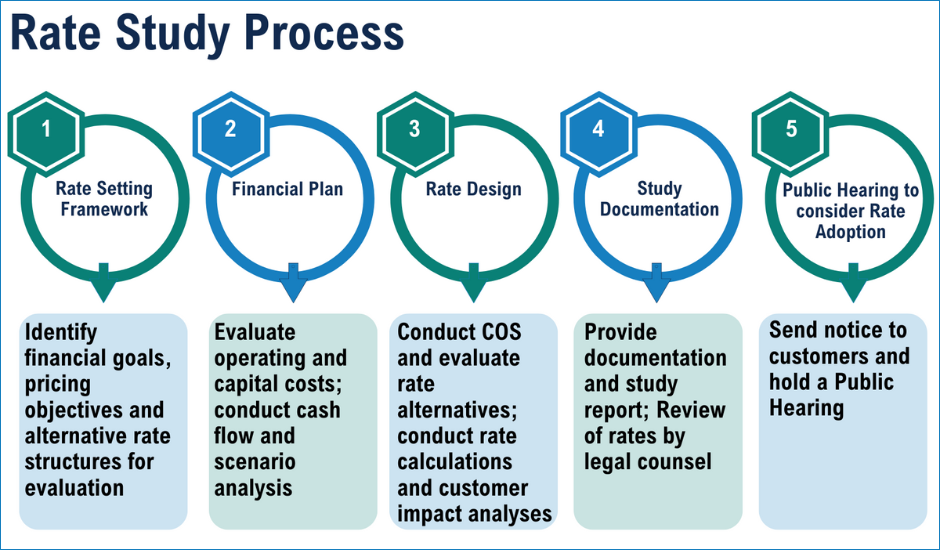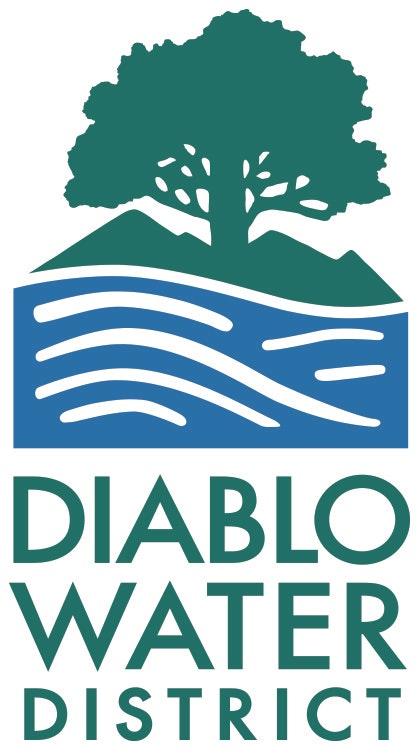Customer FAQs
Diablo Water District is a not-for-profit independent public agency guided by an elected Board of Directors. All revenues are used exclusively to enhance and sustain your water system, including ongoing operations, maintenance, and critical infrastructure upgrades such as water main replacements and fire hydrant maintenance.
To deliver high-quality water, we purchase untreated water from Contra Costa Water District (CCWD), treat the water to exceed drinking water standards, and then blend the treated surface water with groundwater pumped from two wells. Once treated, the blended water is delivered through the District’s distribution system to homes and businesses across our community. Our local groundwater helps reduce reliance on purchased water while maintaining the quality you trust.
The District’s water service is primarily funded through customer rates. Customer payments support the District’s ability to deliver high-quality, reliable water services while remaining environmentally responsible for the resources in our care. The District is committed to good governance, fiscal accountability, and transparency, with systems and policies in place to uphold the trust of our customers.
The District uses industry-leading best practices to ensure a resilient water future. Revenue from water rates are reinvested into infrastructure to maintain system reliability and ensure continuous operations and service delivery. We are currently investing funds in projects, including:
- Maintenance and repair of critical infrastructure, such as water reservoirs, booster stations, and groundwater wells, including ongoing projects like seismic upgrades to a 5-million-gallon reservoir, an Emergency Operations Center and backup generators for continued service during emergencies.
- Constructing a groundwater reverse osmosis treatment plant to increase water quality, drought resilience, and water supply.
- Maintaining more than 175 miles of water pipelines to ensure water delivery to homes and businesses.
- Maintaining, repairing, and replacing more than 1,750 fire hydrants.
- Hiring and retaining highly skilled, qualified, and licensed staff to operate the water system and conduct water quality monitoring.
These investments ensure that Diablo Water District continues to meet the community's water needs reliably and sustainably.
No. By law, we cannot charge customers more than it costs to provide water service. The District’s water system is owned by our customers and governed by the elected Board of Directors; we do not have shareholders or pay dividends.
The District conducts water rate studies every three to five years as an industry standard to ensure transparency and financial stability. These studies help the District plan for long-term water solutions by meeting budget needs, maintaining infrastructure, implementing new technologies, complying with state and federal regulations, and funding the Capital Improvement Program (CIP).
The last multi-year rate adjustments were approved in 2022, but rising costs driven by inflation are impacting critical system operations, maintenance, repairs, replacements, and regulatory compliance— all essential for protecting the health and safety of our community. A new rate study is necessary to ensure the District has the resources to fund these operations and implement future improvements to maintain reliable water service.
An essential part of the rate study includes funding reserves to manage financial risks. Reserves help address challenges such as drought conditions, emergency repairs, natural disasters, and increased costs for purchasing water, all while continuing to provide high-quality water at the lowest possible cost.
Yes. The financial analysis anticipates inflation. The District recognizes the impact of record inflation and continues to take fiscally responsible action amid the ever-increasing impacts that state, national, and international decisions have on our economy. The rate study forecasts anticipated cost increases for buying water and the rising cost of electricity needed to move water from place to place, such as a 12 percent annual rate increase from PG&E and a 6 percent rise in wholesale water rates per year.
The purpose of a five-year rate study is to adjust for differences between expected and actual expenses and income. It helps determine the revenue needed over the next five years to cover costs, address any surpluses or shortfalls, and ensure reserves remain healthy.
Revenue from rates must also fund reserves to handle unforeseen events, like emergency repairs or droughts, and to meet debt obligations. Reserve funds are not used for routine District expenses. The rate study looks ahead with projected costs and expected increases over the next five to 10 years, aiming to keep the budget balanced and prepared for the future.
The rate study and financial conditions take many months of calculations and review. As the rate study progresses, proposed rates may not be known until March or April 2025. California state law (Proposition 218) requires the District to adopt rates that reflect the District’s actual costs of serving each customer type (residential, commercial, industrial, etc.). Throughout the rate study process, the community is encouraged to participate in public meetings and provide input. To submit questions or feedback, send emails to customers@diablowater.org or call (925) 625-3798.
Water is a core service necessary for a healthy community. If rates are not raised, it could negatively impact the reliability and safety of our aging water system. Critical projects, such as climate-resilient efforts to protect against earthquakes and safeguard our groundwater aquifer, and planning for future drought years, would be at risk.
The District would be forced to prioritize only the most urgent operations, potentially deferring major infrastructure upgrades. This delay would leave our existing system vulnerable to failures, increase long-term costs, and could lead to greater regulatory oversight by state and federal permitting agencies. Ensuring reliable water service and public health relies on continual investments in our infrastructure and water supply systems.
In 1996, California voters approved the Right to Vote on Taxes Act, known as Proposition 218, which established requirements for setting local government utility rates, fees, and charges. This legal framework guides how rates and charges for utility services are determined through evaluation and analysis of cost escalations related to operations and maintenance, water treatment and distribution, capital project costs, general inflation, and cost increases for materials and power. Different types of customers generate different costs because of their water use characteristics. Each customer group must pay their fair share and can’t be required to pay the costs incurred by another group. For example, residential customers can’t be required to pay more, so commercial customers can pay less, or vice versa.
Under Proposition 218, property owners and customers will receive a mailed Public Notice detailing proposed rate adjustments, the date of a Public Hearing, and how to protest or object to proposed rates. Property owners will have a minimum of 45 days to petition the proposed rate adjustments through a written process. In the Public Hearing, the District’s Board of Directors will review public comments and written protests and objections and consider approving or denying rate adjustments. Should the District receive a majority protest from customers, rate adjustments will not be implemented.
Typically, there are five steps in a rate study, as shown in the image below. The first step determines a framework based on District and community values and priorities, such as water efficiency, affordability, fiscal responsibility, or rate structures. In step two, a financial plan is conducted to assess how much money the District needs in any given year, which can vary depending on planned capital projects. Next, a Cost of Service (COS) and rate design is conducted involving detailed calculations, rate alternatives, and customer impacts. Once a rate proposal is determined, the study is documented in a Study Report that will serve as part of the District’s administrative record. Finally, in step five, District customers will be notified of proposed rates no less than 45 days before the Public Hearing where the Board will consider adopting proposed rates.

Yes, as required by California law, property owners will receive a Proposition 218 Public Notice detailing the proposed rate adjustments, petition process, and the date of the Public Hearing. Written protests will be accepted until the close of the Public Hearing.
The District Board of Directors will hold a Public Hearing to review written protests and consider approving or denying rate adjustments. Should the District receive a majority protest from our service area, new rates will not be implemented. Only one valid protest per street address or parcel will be counted for purposes of the protest process.


